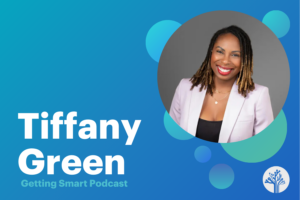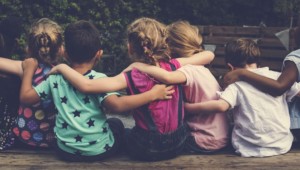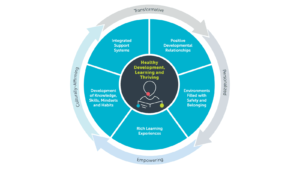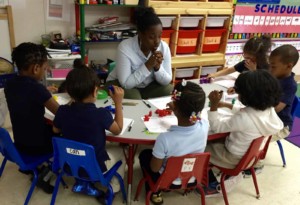Developing the Whole Child One Collaboration at a Time

By: Dr. Lindsay Portnoy
Barrington Rhode Island is not your ordinary town. Located less than a dozen miles from Providence, Barrington has been named one of the best places to live in the U.S. as a result of several factors including housing costs and student success rates. Barrington schools are also home to some of the most forward-thinking educators in our country. Several years back Northeastern’s NExT initiative inspired the Barrington district to make the leap towards experiential learning and the results have been staggering. Middle school robotics teacher Rebecca Henderson and digital literacy teacher Mark Davis are two of the innovative educators who readily embraced this challenge. Their efforts demonstrate the power of teacher collaborations to create interdisciplinary instruction that is multimodal in nature and includes the important aspects of self-, peer- and teacher reflection.
As part of a deeper learning initiative at Barrington Schools, Henderson and Davis had been given time to plan together and think about how teaching the whole child includes both deep content knowledge and social and emotional skills that are enhanced through opportunities to use the 4 C’s of collaboration, communication, critical thinking, and creativity in the classroom. As they discussed how these skills were being taught in their classrooms they were curious to see if their students could take a difficult task they learned in class and teach it to peers in the other teacher’s class. Henderson and Davis understood that often the most difficult part of learning is understanding something well enough to teach it to others, and that is where their journey began.
Two Teams, One Purpose: If You Know it, You Can Teach It
Henderson’s STEAM Studio and Robotics courses are interdisciplinary in nature and are home to a cornucopia of tools for solving complex problems. Students are exposed to a variety of tools from EV3/NXT robots with mindstorms software, 3D Ultimaker printer, 3Doodle pens and Spheros to Cubelets and Makey Makey among many others. But her main goal in working with students is to demonstrate that tools are vehicles for solving problems led by student curiosity. Team Henderson was knee deep in experiential learning using digital tools such as 3D printers at the beginning of this collaboration where minds and bodies were already actively engaged in deep content learning. Could her students communicate their learning on Blocks Cad to Team Davis?
Down the hall, Team Davis was immersed in a unit called Electric Maze where they looked at coding as a tool for problem solving. Students worked to deconstruct applications to see what’s under the hood and then using their coding skills to problem solve or program new tools. Using their knowledge, Team Davis students have worked to program microprocessors and drones, produced podcasts and instructional videos. The goal of Davis’s work with students is to emphasize the process and not the product while also fostering communication, collaboration, critical thinking and creativity in his students. Could his students explain their understanding of the Electric Maze to Team Henderson?

Feedback For the Win: The Iterative Process of Feedback
Henderson and Davis asked their students to prepare a short lesson to teach their skills to their peers. To reinforce reflective practice, Henderson and Davis created a structure for providing deliberate feedback after each group’s presentation to ensure students received information about their areas of strength (glows) and areas needing strengthening (grows). Feedback would first be given by peers allowing the student presenters and teachers to calibrate their own assessment with the perspective of first-time learners. Student presenters would then be invited to respond and share a self-assessment including areas they might like to try to reteach or re-conceptualize. The cooperating teacher then provided formative feedback to reinforce strengths and opportunities for growth and finally, the teacher of record provided feedback synthesizing all of the comments and modeling how feedback fuels ongoing learning. Going into the project Davis thought, “we’ve lived the design process together and believe that to support all learners we have to be open to critical feedback. We don’t know what’s going to happen and that’s okay.”

The day of the presentations arrived and Team Henderson began their presentation on Blocks CAD software and building /programming an NXT robot. Davis team was quick to provide glows (e.g., “the artifacts were well designed and the team was really motivated!”) and grows (e.g., “the steps seemed rushed and there weren’t any transitions”). The presenters from Team Henderson reflected with their own glows (e.g., “we connected their coding skills to our work”) and grows (e.g., “our leadership wasn’t strong enough”). Next Mr. Davis shared his glows (e.g., “great visuals”) and grows (e.g., “I wish that each person had a clear role in the lesson”) with the presenters. Lastly, Mrs. Henderson reinforced feedback from others and shared her own glows (e.g., “great problem solving”) and grows (e.g., “I wonder if you could have added more time between steps for students to reflect and check their understanding”) with the presenting group.
Team Davis followed with their presentations of the game Electric Maze. Students from Team Henderson were first to share their glows (e.g., “having specific roles was great”) and grows (e.g., “saying you will learn when you try was more confusing”). The presenters from Team Davis were then able to share their reflected glows (e.g., “everyone made it through the maze!”) and grows (e.g., “we could have prepared what we would say a bit better”). Next Mrs. Henderson shared her glows (e.g., Good job explaining the game”) and grows (e.g., “it was confusing when you said you will learn when you try it because we didn’t have steps to take if we were confused”) with the presenters. Mr. Davis gave his glows (e.g., “Everyone completed the task”) and grows (e.g., “Could have done more to explain the procedures”) to the presenting group.

Collaboration, Communication, & Problem-Solving: Modeling the Skills We Teach
The magic of this duo is in their relentless pursuit of improvement and openness to show students that learning is an iterative process. While each educator has different content to teach they are still very much on the same team. “I’m learning with my students. For me, showing that I’m learning material with them is the most powerful.” Davis agrees, adding, “I’m okay with not knowing. I show my students that I have the strategies that will help me get to understand the content.” Both Davis and Henderson talk about how these skills go beyond the classroom and apply to so many facets of their lives. And it appears as if this mindset is impacting learners as well. One student reflected on the experience to say, “I didn’t realize how much of this I use outside of school.” Giving students the opportunity to respond to critical feedback learn that what defines them is how they use feedback to improve for next time. These are critical skills for working successfully together and supporting each other through complex projects today and in the future.
Several colleagues remarked how they “wish they had this type of learning when they were in school” while others have repeatedly suggested they’d love to “bring outside visitors into the school to see the powerful collaboration and tools being used.” Parents have shared their gratitude for this renewed way of teaching and learning beaming, “our children come home excited to share what they did” and “the projects are helping my child express themselves in a different way than before.” Modeling continued growth through collaboration and communication, these educators have created a culture of persistence and problem-solving in their classrooms, something that should be elevated and celebrated on a global scale and a yet another reason why Barrington is actually quite extraordinary.
For more, see:
- Collaboration: Bringing Students Together to Promote Learning
- How Continuous Feedback Fosters Learning
- Collaboration: Key to Successful Teams and Projects
Dr. Lindsay Portnoy is a cognitive psychologist, researcher and Chief Learning Officer at Killer Snails working and writing at the intersection of cognition, assessment for learning, and emerging technology. Connect with her on Twitter: @lportnoy.
Stay in-the-know with all things edtech and innovations in learning by signing up to receive our weekly newsletter, Smart Update.







0 Comments
Leave a Comment
Your email address will not be published. All fields are required.